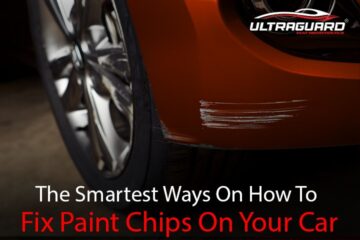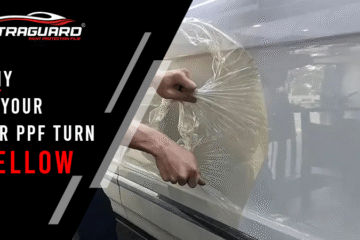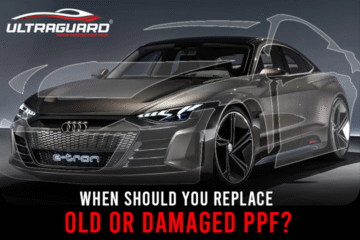The automotive care industry provides a myriad of options, all claiming to maintain your beloved vehicle in tip-top condition. One of the most controversial ways to preserve and protect a vehicle’s body is PPF coating vs paint respray. Although both will revamp your car’s face, they take very different methodologies and provide very different advantages. This in-depth guide will explore the nitty-gritty of Paint Protection Film (PPF) coating and a complete paint respray, enabling you to decide which is the wiser option for your particular requirements.

PPF Coating vs Paint Respray: Learning the Basics
Before we contrast the two directly, let’s learn what each of these processes involves.
What is PPF Coating?
A clear, thermoplastic urethane film, is applied to the surface of your car. Its sole intention is to guard the original paint against damage from the outside world. Contemporary PPF coatings are very resilient, flexible, and sometimes self-healing, i.e., scratches and swirl marks vanish with the use of heat.
Key features of PPF Coating
Transparency
It melts to your car’s paint, to maintain its paint and factory finish
Protection
It protects the paint from stone chips, minor scratches, insect splatters, bird droppings, and UV rays.
Self-healing Properties
One of the best properties of paint protection film is that it can heal slight scratches and swirl marks when subjected to heat (sun, hot water, or heat gun).
Hydrophobic
PPF coating provides this feature, which makes it simpler to clean the car, and the water rolls off the car’s surface itself.
Durability
Generally, PPFs last up to 5-10 years, based on the quality and installation of the film.
Removability
Is removable without causing any harm to the factory paint underneath, thus making it a non-permanent solution.
What is a Paint Respray?
A paint respray, as indicated by its name, consists of re-painting one or all of the panels, or even the whole vehicle. This can consist of sanding off the current coat of paint, the application of primer, several coats of fresh paint (base coat), and then various layers of clear coat for protection as well as gloss. A respray is normally done when the original paint has been badly damaged, or faded, or if the owner wants a total color change.
Main features of a Paint Respray
Complete restoration/color change
Can restore a severely damaged or faded paint job entirely, or permit a radical color change.
Coverage
Deals with severe scratches, dents, heavy fading, and rust by covering them entirely.
Cost
Typically costlier and more time-consuming than a PPF application, particularly for a complete respray.
Steps
Extensive prep work, such as sanding, masking, and application of several layers of paint.
Authenticity
To give your car a new look, you can repair it, but it can end up losing its original paint, which can become an issue at the time of resale.
Durability
The durability of respray paint depends on the type and quality of the paint and the painter.
PPF Coating vs Paint Respray: A Comparison You Needed!
Now that we know the fundamentals, let’s compare PPF coating vs paint respray head-to-head in different important areas.
1. Purpose and Objective
PPF Coating
The main objective of a PPF coating is protection. It’s about keeping the factory paint job in its original state, avoiding damage from the outside world, and keeping the vehicle looking good for longer. It’s an investment in protecting your car’s original finish.
Paint Respray
Restoration or metamorphosis is the primary use of a paint respray. It’s selected when the original paint is unrecoverable, extensively worn out, or if one wishes to make a full-color changeover. It’s more about returning vitality to an exhausted exterior or giving it a new identity altogether.
2. Protection Provided
PPF Coating
Provides a much higher level of protection from physical damage such as stone chips, small scratches, swirl marks, insect acids, bird droppings, and road tar. It is also a sacrificial coating, taking the brunt of the impact and damage that would otherwise hit the paint. UV protection also avoids fading.
Paint Respray
Although a fresh paint job appears new, it has no built-in protective coating against physical harm. After respraying, the new paint is as prone to chips, scratches, and environmental hazards as any other paint finish. To guard a resprayed vehicle, you would still have to look into such options as PPF or ceramic coatings.
3. Aesthetics and Finish
PPF Coating
An excellent PPF coating is very hard to see. It adds depth and gloss to the original paint without changing its color or texture. New-age films are amazingly clear and won’t yellow with age.
Paint Respray
An all-over professional respray can make a car appear brand new, with a rich, even, and glossy finish. But the finish quality will also depend highly on the painter’s expertise and paint material quality. Also, there is the risk of a slightly different color, especially when repainting only some panels, on metallic or pearl finishes.
4. Cost Implications
PPF Coating
Depending on the coverage (whole car, front end, or specific panels), the film’s quality, and the installer’s level of experience, PPF coating prices can vary greatly. In India, the cost of a full-car PPF application can range from ₹40K to ₹3L+. Even while it could seem like a big upfront expense, it’s an investment in keeping the original paint and possibly preventing future, more costly repairs.
Paint Respray
A complete paint respray will be more costly than a complete PPF job. It can cost between ₹80K and ₹5L+ based on the size of the car, type of paint used, complexity of the job, and body shop reputation. Just repainting one panel will also be expensive, usually between ₹10K and ₹30K for each panel.
5. Durability and Longevity
PPF Coating
The majority of high-quality PPF films are warranted for 5 to 10 years to provide long-term protection. They exhibit superior durability, withstanding yellowing, cracking, and peeling if well maintained.
Paint Respray
The durability of a resprayed paint job will solely be dependent on the quality of the materials and the process of application. A low-cost respray may begin to fade, chip, or peel after a few years, whereas a good quality job could last for decades. But it will still be subject to the same wear and tear as factory paint.
6. Installation Process and Time
PPF Coating
PPF application is a very careful process that involves experienced technicians. It includes extensive cleaning, accurate cutting of the film to fit the car’s panels, and gentle application in order not to get any bubbles or defects. A complete car PPF installation may take 2-5 days.
Paint Respray
A full respray with paint is a much more labor-intensive and time-consuming task. It necessitates a great deal of preparation, such as sanding, masking, applying primer, two or more coats of paint, and a clear coat, then a curing time. A full respray can last from 1-3 weeks, or longer, depending on how much work is involved.
7. Effect on Resale Value
PPF Coating
A properly applied PPF coating can be beneficial to resale value. It shows the owner took proactive measures to safeguard the original paint of the vehicle, which is extremely attractive to potential buyers. Being able to remove the film and expose pristine factory paint is a big selling feature.
Paint Respray
A respray of the entire paint job, particularly if not carried out by the factory, is detrimental to resale value, especially on newer or collector vehicles. Purchases tend to want factory original paint. Although an accident-caused high-quality respray would be tolerable with the right records, a respray purely for cosmetic purposes (not because of damage) can be questioned and decrease the car’s value. For less valuable or older vehicles, a good respray will improve looks and hence sellability, but seldom even adds much monetary value other than to pay for the spray itself.
8. Maintenance
PPF Coating
Vehicles with PPF coating tend to be easier to take care of. The smooth, water-repelling surface is easier to clean and resists dirt and water. Minor swirl marks are less noticeable due to their self-healing abilities. Wash it regularly and use detail sprays every now and then.
Paint Respray
If the car is being resprayed, its maintenance will be the same as for the original paint. It needs to be washed, waxed, and polished every now and then to keep it shining bright and safe from the weather. The clear coat used during the respray job would play a key role in how easy it is to retain the shine.
When is PPF Coating the Smarter Choice?
Based on the detailed comparison, PPF coating is in most cases the better option in the following scenarios:
New or Almost New Cars
If you have just bought a new vehicle or own a vehicle with a pristine factory paint finish, PPF is the solution of choice to maintain its originality and safeguard it against everyday wear and tear. This is where the PPF coating vs paint respray debate strongly favors PPF.
Long-Term Paint Protection Desire
If keeping your car’s paint protected from stone chips, scratches, bug splatters, and weathering for several years without changing its factory finish is your top priority, PPF is unparalleled.
Resale Value Concern
For potential future sellers who wish to retain their car’s best possible resale value by keeping its original paint intact, PPF is priceless.
Looking for Easy Maintenance
If you desire a protective film that makes your vehicle simpler to clean and minimizes the need for excessive waxing or polishing, PPF’s self-healing and hydrophobic qualities are a significant selling point.
Valuable or Special-Purpose Vehicles
In luxury vehicles, sports cars, or vintage vehicles where original paint is the key to value, a PPF coating is a valuable investment.
When is a Paint Respray the Wiser Option?
On the other hand, a paint respray is the wiser option in the following circumstances:
Severely Damaged or Faded Paint
If your car’s paint is badly damaged with severe scratches, heavy fading, rust, or large sections of clear coat failure, a respray is usually the only possible way to get it looking like new again.
Desire for a Colour Change
If you’re tired of the color your car is and wish for a complete change, a full respray is the solution.
Restoring a Classic or Project Car
For older cars that are being fully restored, where the original paint is either gone or beyond repair, a respray is a part of the restoration process.
Budget Limitations for Minor Damage
On extremely localized, in-deep scratches or dents on one panel, sometimes a spot respray of said panel could be more economical than covering the entire area in PPF if the remainder of the car’s paint is not an issue. But painting exactly to match is difficult.
The Hybrid Approach: Best of Both Worlds
It’s also important to mention that you don’t necessarily need to decide exclusively between PPF coating vs. paint respray. A hybrid solution can provide the advantages of both worlds:
Respray Only Damaged Panels, Then PPF
If you have a handful of panels with extensive damage, you may want to respray only those panels to bring them back to the original color, and then apply a full PPF covering to the entire vehicle. This fixes the damaged panels and then shields the freshly painted and original factory paint.
Partial PPF After Respray
For a car resprayed for the first time, particularly a high-standard job you do not wish to damage, depositing PPF in key impact zones such as the front bumper, hood, fenders, and side mirrors can be a vital defensive measure against chips and scratches.
Final Judgment: PPF Coating vs Paint Respray – Which is Smarter
The “smarter” option between paint respray and PPF coating ultimately comes down to your goals, budget, and the state of your car.
A PPF coating is the more sensible and progressive choice if the paint on your car is in good to exceptional condition, and preservation, protection, and preserving the original factory finish are your top priorities.
The payoff in the long run for a Paint Protection Film is exponentially more than the upfront cost in terms of averting future damage and maintaining original appearance. If your car’s paint is badly damaged, or heavily faded, or you simply want a full color change, then a paint respray is the solution for you. It’s a repair procedure that revitalizes or transforms your vehicle. However, to maintain its brand-new look, a resprayed car still requires protection treatments like a PPF coating or ceramic coating.
Frequently Asked Questions(FAQs)
1. Can I apply PPF over a resprayed car?
Absolutely, yes! It is extremely advisable if you’ve spent money on a quality respray with high-grade paint. Having a Paint Protection Film applied over recently painted finishes will guarantee protection for the new paint from scratches, chips, and exposure to the elements, basically providing it with the same protection as the factory’s original paint. Make sure the respray has cured completely prior to applying PPF.
2. Will PPF yellow over time?
Early generations of PPF would yellow with age, particularly when exposed to UV light over long periods. New generation, high-grade PPF coatings have been formulated with sophisticated UV inhibitors that inhibit yellowing and retain their clarity for decades, usually with a 5-10 year warranty against yellowing.
3. How long does a paint respray last, about PPF?
The life span of a paint respray is highly variable based on the quality of workmanship and materials; a low-cost one could deplete in a couple of years, while an excellent one could last 10+ years. Its resistance to physical wear, however, is inherent to paint.
4. Is a PPF coating worth it?
For a new vehicle, a high-end vehicle, or an owner who wants to ensure their original factory paint and resale value are retained, a PPF coating is usually worth it. It really minimizes the cost of expensive paint repair from chips and scratches, and simplifies washing the car.
5. Will a paint respray cover up all prior damage?
Most damage is concealable by a professional respray of paint, such as deep scratches, dents (with proper prep), and fading. But the finish’s quality rests on the initial work of repair. Any defect in the bodywork or prep will be revealed through the new coat.
6. What are the primary indications that I need a paint respray instead of PPF?
You probably require a paint respray if your vehicle has severe clear coat failure (flaking or peeling), extensive deep scratches that penetrate through the clear coat, extensive fading on numerous panels, extensive rust spots, or extensive accident damage areas. PPF is meant for protection from such damage, not repairing it.
7. Is Paint Protection Film the same as ceramic coating?
No, they are distinct, though sometimes complementary. Paint Protection Film (PPF) is a physical, thick urethane film that functions as a strong barrier against physical harm, such as chips and scratches. A ceramic coating is a liquid polymer that chemically bonds to the car’s factory paint, forming a hydrophobic layer that provides gloss, UV protection, and ease of cleaning, but little physical protection from impacts.




0 Comments